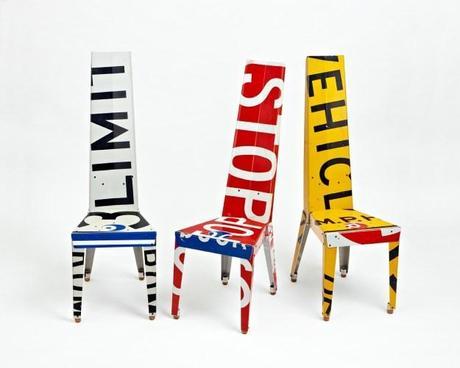
Photo courtesy of Boris Bally.
Remember that fun little article we posted a few weeks ago that showed you some of the strangest materials people have used to make chairs? Well, as it so happens, one of the designers, Boris Bally, happily agreed to answer a few questions for us.
Boris has designed a variety of things, from furniture and housewares to installations and experimental pieces. Click through to learn about his personal philosophy, design process, intended artistic statements, and more.
What led you to “reuse,” the reference point on which to set your work? How did your design activity start?
My efforts did not begin from sincerity, rather through my upbringing and culture as mentioned below. I just wanted to make ‘cool stuff.’ I have been to Switzerland on numerous trips throughout my life, and I was apprenticed as a goldsmith in Basel 1979-80. As a way of conscious life they recycle and always have, always will. They are programmed not to waste. I saw this and learned that they have been doing this since the 70′s, if not before; culturally they know what tough times are like. I began working with garbage not to fit a trend (there wasn’t one yet!) but rather as a challenge.
I still run my life (and as a family we all do) to reduce waste, recycle, upcycle and make do. My studio is a recycled School-turned-American Legion Building (1889) which I bought in ’99 at the cost of an automobile. They were going to tear down this monument; I saved and restored it. The staircase railing is made from shovels my UPS driver gave me. The window grates are made of drills the electricians discarded when they ran the power in this place.
My designs are made locally, by my studio manager Rob Boyd or myself, by hand (Humanufactured®) with basic, small tools, minimizing consumption of electrical power. We get our material in my eco-minivan, mostly regionally. We triage (designate and assign) signage for its optimal traits. For example, a large sign with a great image becomes a chair back. Too thin? It becomes ‘spun’ into a platter. Too plentiful (not a scarce image) becomes a tray. We further utilize the ‘leftovers’ of the initial process to become the smaller, abstracted objects such as coasters, key fobs, and wearable brooches. What is left over in the end is metal sawdust and small scraps, which I bring back to the scrap yard to get it back into the recycling routine. The work itself is designed to ship flat and the consumer assembles it. Goal: to save space, money, packing material, and unnecessary costs for shipping. Perk: It allows me to ship anywhere!
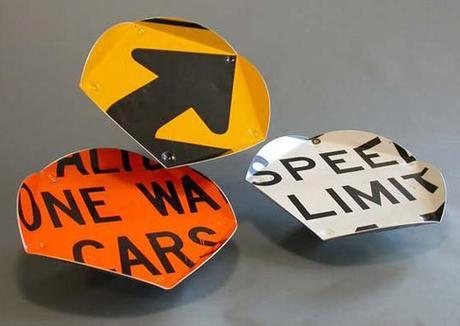
Photo from inhabitat.
Why do you enjoy working with these materials?
Because the challenge is far greater than working with precious materials! Making something people value from something they have discarded is the ultimate challenge. It’s getting them to pay big bucks for your design made of their own discards. Essentially, it’s ‘repackaging the material and selling it back to them!’ Making something sexy and ‘valuable’ from gold is easy – try doing that with garbage! I hope to be the ultimate urban alchemist! Previously I had been working in (and trained in) precious and semi-precious metals and woods (ebony, silver, gold, diamonds, rubies, etc.) My family culture and history is Swiss (my parents both came from Zürich in the early ’60s). They believe firmly in ‘use it up, wear it, out, make it do, do without’ — which has been our family motto. Growing up, other kids went to the zoo on weekends, while my parents took us to scrap yards around Pittsburgh.
Have you ever had difficulty in obtaining the materials to be reused?
Yes, always. There are politics involved. Also, there is the expense and intrinsic value of the aluminum. I must outbid all the other scrap specialists to have the ability to acquire the signs.
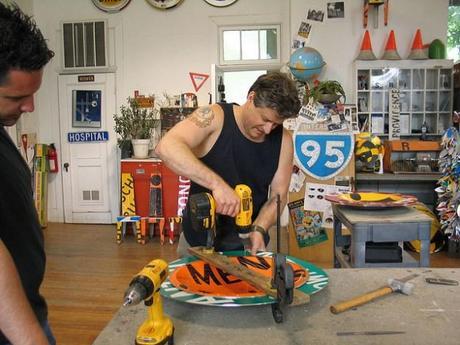
Photo by Winthrop University Jewelry + Metals.
What does the process look like for making one of your street sign chairs? Guide me through step by step. How long does this process generally take?
It takes about 2 days to make a chair. First we select the desired signs and decide which parts to use for what. The materials used in my studio are selected for their ability to delight, invite and subversively educate. The materials invite accessibility, including larger segments of culture, from members of the general public of all ages to the more design and art savvy. Much effort goes into the location, purchasing, and selection of the optimal signage materials. With my work, I hope to open minds to realizing that recycled work doesn’t have to appear dismal, alienate, lack in comfort or be unaffordable.
Then we test the signs for bending to be sure they do not snap. Then we trace the pattern and cut the blanks out with a bandsaw. The pieces are hand-sanded and all edges hand-filed. The components are then hand-bent in a bending brake. The pieces are fit together and fastened with stainless steel fasteners. After that, the chair is disassembled, cleaned and ‘tweaked’ with a hand-file for ultra-perfect edges and fit. Finally, the pieces are sealed with a wax and packed, complete with instructions, hardware, and assembly tool, ready to be shipped!
During production of these chairs, nothing goes to waste. Anything left over from the chair manufacturing process is further used in the production of numerous other furnishing designs (switch plates, mailboxes, house numbers, clocks, picture frames and even key fobs).
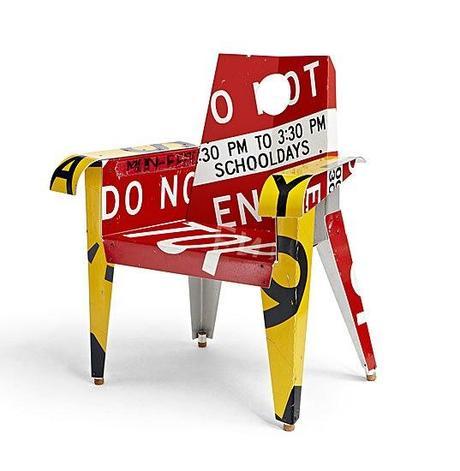
Photo from Artful Home.
Why would someone want to include your street sign furniture in their home? What design style or niche does it fit into?
Because these designs are innovative and pioneering in their approach, especially regarding material use, for the creation of furniture. This is why numerous international museums include the work in their collections and countless publications have included my work as examples of an iconic, signature design for the 90′s. The work is sort of pop meets green.
Why do traffic signs resonate with you and what do they symbolize for people in general?
Through an ongoing exploration of common and radical materials, I attempt to break down the boundaries presented in art and design. Exploring novel techniques, formerly restricted to the craft world, often initiates new directions for exploration. I enjoy responding to technical challenges that emerge to produce useful pieces of integrity, which are often laced with political or emotional content. Usually designing in “series,” I make calculated incremental changes with critical review after each completed prototype. Finished pieces are only a temporary solution, leaving room for continued experimentation and further refinement.
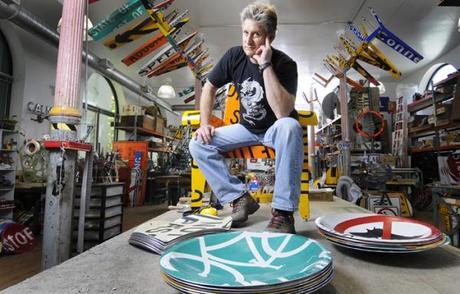
Photo from Digital Dads.
Your bio says that you see yourself as a cultural critic. What does this mean to you personally? What aspects of society and our current culture do you explore?
The work, by virtue of its material use, underlying themes (anti-violence, eco-design), and wit becomes subversive and sometimes blatant social commentary.
What do you have in the works in terms of future projects?
In my studio, we have begun to create massive installations. This is a direction worthy of exploration. I am also preparing some sculptural ideas for a few special international exhibitions this year.
I would like to thank Boris Bally for the time and care he took he answering my questions. If you would like to see more of his work, click here to visit his website.

